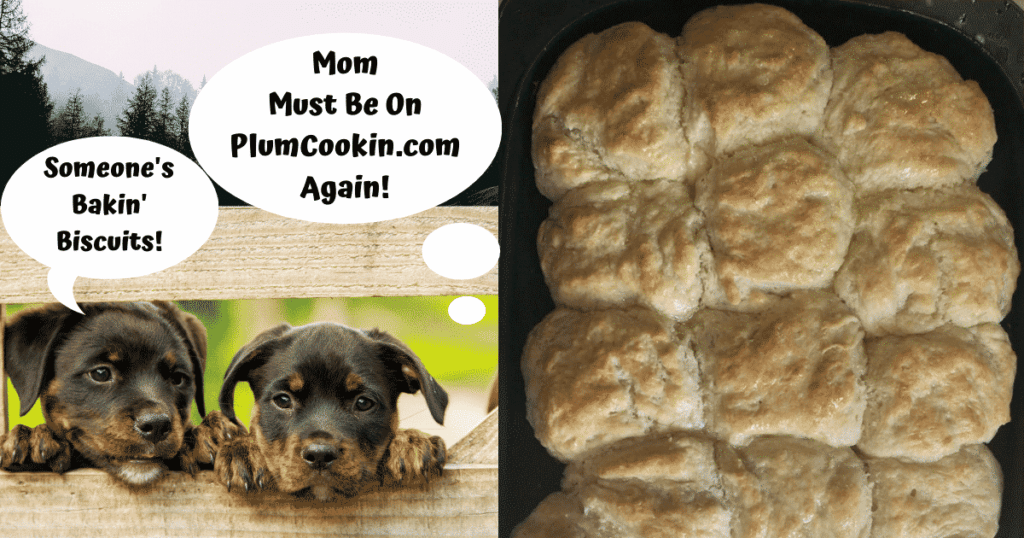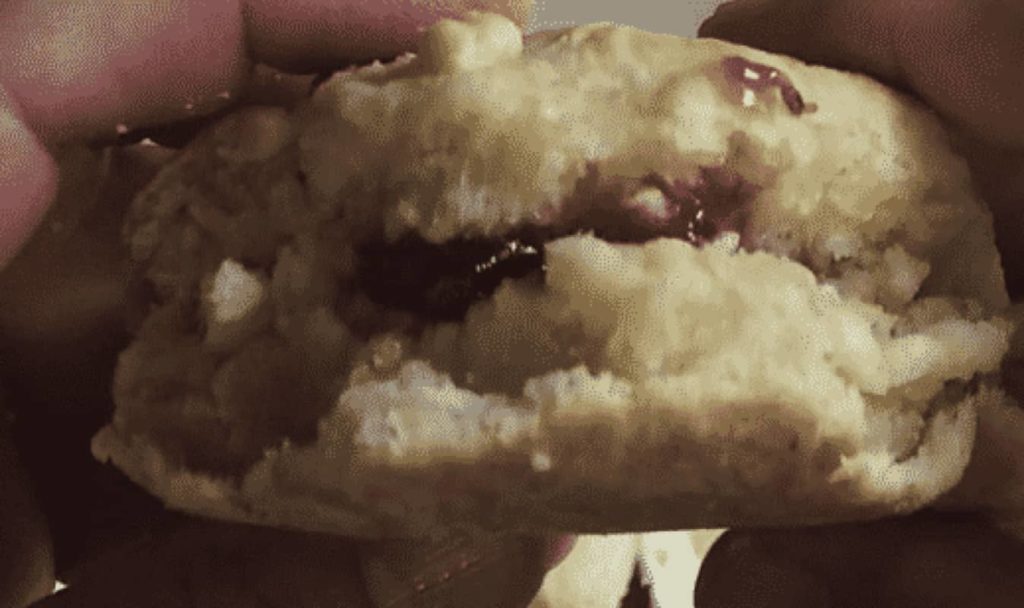
Best Homemade Biscuits Almost From Scratch

Someone's Baking Homemade Biscuits

One of my all-time favorites with breakfast in the morning is good, old-fashioned homemade biscuits. Especially buttermilk biscuits.
It could be homemade biscuits for biscuits and gravy. It could be homemade biscuits for a breakfast sandwich, such as sausage, egg, and cheese. Maybe it's a plate full of scrambled eggs, bacon, and a fresh hot homemade biscuit on the side with butter and honey or perhaps old-fashioned homemade strawberry jam.
No matter how you like your breakfast, it's just plain hard to beat the smell of fresh warm homemade biscuits coming straight out of the oven in the morning.
People don't make biscuits from scratch much these days because they either don't think they have the time, don't think they have the skills, or have just never learned how, and they're intimidated by the whole process.
The truth is, that biscuit making can be very simple or very complicated. It's up to you just how much work you want to put into making homemade biscuits.
But It Says "Just Like Homemade" On The Can
Nowadays, most people peel back the paper label to bust open one of those refrigerated cans of biscuit dough and pop them in the oven because that's all they think they have time to do. Sadly, I've yet to find a canned biscuit that comes remotely close to homemade biscuits, let alone a buttermilk biscuit.
Other alternatives include the pre-made, cooked or uncooked biscuits you can find in the freezer section at your local supermarket, and yes, they tend to be closer to the real thing than those canned biscuits. The trouble is, for anyone who has ever tasted real homemade biscuits, that canned or frozen version is just not going to do the trick.
If you seriously don't have the time or desire to make homemade biscuits from scratch every time you want to have biscuits. Without question, there are a few excellent mixes out there for homemade biscuits. If you're going to go that route and buy a pre-made mix, here are a few brands we've found on Amazon that get the Plum Cookin' recommendation.
Southern Biscuit Formula L Biscuit Mix
Weisenberger - Southern Style Buttermilk Biscuit Mix
Better Still - Make Your Mix Yourself
If you're going to use a mix, why not have all the convenience without the cost, preservatives, or unpronounceable ingredients of a store-bought mix? All you need is a reusable, airtight container and half a dozen ingredients you probably already have in your pantry to make a shelf-stable mix of your own.
What Type of Milk Should I Use
You can make any of the various homemade biscuits listed here using just about any variety of milk, ranging from powdered non-fat to heavy liquid cream. My favorite by far, however, is made with fresh cultured buttermilk.
If you don't have any buttermilk on hand, you can make sour milk in a pinch by adding a tablespoon of vinegar or lemon juice to a cup of milk and letting it curdle for about ten minutes. The resulting biscuit won't be quite the same as a fluffy, homemade buttermilk biscuit, but in a pinch, what can I say? It works.
Drop Biscuits
If you look on the back of many biscuit mixes, you'll find various recipes, one being drop biscuits.
Now, if you're looking for something simple, it just doesn't get much easier than drop biscuits from your pre-made, homemade biscuit and baking mix. Making biscuits this way is so easy there's no reason to limit them to breakfast either. Drop biscuits are an easy and delicious addition to just about any meal or snack. I've even used them to make my topping for that quick peach cobbler I was craving at the last minute.
Drop biscuits are a slightly thinner, sticky mix of dough that you scoop out by the spoonful and drop onto a lightly greased or non-stick pan.
To make 8 to 12 Drop Biscuits from your homemade baking mix, preheat your oven to 425 degrees. Then, in a large bowl, add 2 1/2 cups of your homemade biscuit mix and 3/4 to 1 cup of buttermilk, and stir just until combined. You can use any milk you like, but buttermilk will give you the best flavor.
If the batter is very dry, add a little more milk until you have the consistency of an incredibly thick batter. Do not over-mix though the batter will be lumpy.
Using a cookie scoop or a spoon, scoop out large dollops of dough (about a quarter cup in size) and drop them onto a non-stick baking pan. If you use a cast iron pan or any pan that tends to stick, you may want to, lightly grease the pan. Parchment paper works well also.
Bake for 12 to 14 minutes or until the tops are golden brown. Brush the tops of the biscuits with melted butter if desired.
You can make drop biscuits in your oven or a pan on your stovetop. I've also baked up a batch of these tasty homemade biscuits in the morning using a cast-iron skillet over a campfire.
Cathead Biscuits
Another biscuit you can make, my Aunt Joanie in Alabama used to call Cathead Biscuits. These homemade biscuits get their name because the biscuit generally bakes up to be about the size of, you guessed it, a cat's head.
Cathead biscuits are made with a thicker and less sticky dough than drop biscuits and are generally shaped by pinching off a piece of dough and rolling it in your floured hand to shape it, rather than using a biscuit cutter.
To make 8 Cathead Biscuits from your homemade baking mix, preheat your oven to 425 degrees. Then, in a large bowl, add 2 1/2 cups of your homemade biscuit mix and 3/4 to 1 cup of buttermilk, and stir until the dough forms a ball. If the batter is sticky, don't be afraid to add a little more baking mix but don't over-mix.
To form the Cathead Biscuits, flour your hands and pinch off a large piece of dough. Give the dough a good roll in your hands to create your biscuit and place it onto a greased or non-stick baking pan.
Bake for 12 to 14 minutes or until the tops are golden brown. Brush the tops of the homemade biscuits with melted butter if desired.
Rolled Biscuits

If you've never made Rolled Buttermilk Biscuits before, you've been missing out on some of the lightest, fluffiest homemade biscuits ever. Admittedly, a perfect Rolled Buttermilk Biscuit may take a little practice, but there's nothing wrong with a few delicious mistakes along the way.
To make 12 to 15 Rolled Buttermilk Biscuits from your homemade mix, you're going to need 4 1/2 cups of your homemade biscuit mix and 1 1/2 to 2 cups of buttermilk. Bring together the homemade mix with the buttermilk and flour your clean work surface with some extra biscuit mix.
Placing your mixed dough onto the floured work surface, pat the dough out by hand to form a large rectangular shape, about 1/2 to 3/4 of an inch thick. If you use a rolling pin for this, be gentle, it's easy to overwork your dough when using a rolling pin. I find it much easier to just pat mine out by hand.
Fold one end of the rectangle halfway over the middle, and then bring the other half over the top. Rotate your dough 90 degrees and pat the dough out to a 1/2 to 3/4 inch thick rectangle again. Repeat the folding process, rotate the dough again, pat the dough out again, repeating the whole process a third time.
Gently pat the dough out into a large rectangle about 3/4 of an inch thick a fourth time and use a large biscuit cutter to cut your biscuits. Cut the biscuits from the dough as closely as you can to get as many biscuits as you can out of a single piece of dough. Gently pat out any extra dough and continue to cut and shape biscuits until all the dough is gone.
Place your biscuits onto a non-stick or lightly greased baking dish. You can also line a pan with parchment paper if you prefer. For tall, fluffy biscuits, make sure the biscuits are touching each other in the pan.
Place the biscuits into a 425-degree oven for 12 to 14 minutes or until the tops are lightly golden brown. When you pull the pan from the oven, you can immediately brush the tops of the homemade biscuits with melted butter if desired.
There is nothing quite like real homemade buttermilk biscuits. This recipe uses my homemade biscuit mix and my homemade buttermilk.
- 4½ cup homemade biscuit mix
- 2 cup homemade cultured buttermilk
- Preheat
Preheat oven to 425 degrees
- Mix
Place your homemade biscuit mix into a mixing bowl. Add the buttermilk and mix just until everything is moistened and there is no dry mix in the bottom of the bowl.
- Knead
Flour your countertop or work surface and your hands with some extra biscuit mix and move the mix from the bowl to your work surface. Knead the dough lightly, adding enough dry mix to keep the dough from sticking. Don't overwork the dough, it should be loose and pliable.
- Roll
You can use a rolling pin here if you prefer but your hands will work best. You what to work this tough gently so a rolling pin is a bit on an overkill. Pat the dough out into a large rectangle and when it gets to be 1/2 to 3/4 of inch thick fold it in half and continue to pat out. Repeat this step 4 to 6 times working the dough out a little further each time. This creates those flaky layers you want in your biscuits. Work the final dough out to a 3/4 thick piece of dough. You can watch the video below to see how to do this.
- Cut
Use a biscuit cutter or regular canning ring to cut and shape your biscuits. You should get about 15 of them. Arrange the biscuits on a non-stick or lightly greased baking pan so that they are just touching one another on the pan.
- Bake
Bake at 425 for 10 to 14 minutes or until the tops begin to turn golden brown. Brush the tops of the pan of golden brown biscuits with melted butter and serve warm.
Servings 15
- Amount Per Serving
- Calories 174kcal
- % Daily Value *
- Total Fat 7g11%
- Saturated Fat 2g10%
- Sodium 493mg21%
- Potassium 102mg3%
- Total Carbohydrate 24g8%
- Dietary Fiber 1g4%
- Sugars 6g
- Protein 4g8%
- Vitamin A 53 IU
- Vitamin C 1 mg
- Calcium 101 mg
- Iron 1 mg
* Percent Daily Values are based on a 2,000 calorie diet. Your daily value may be higher or lower depending on your calorie needs.
